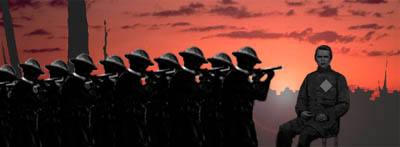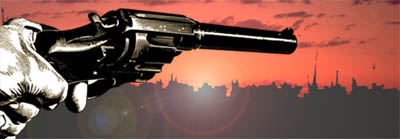|
Victor
Silvester wrote about his experiences in the First World War in
his autobiography Dancing Is My Life.
This is his story:
The mood of the country
was one of almost hysterical patriotism, and no excuses were accepted
for any man of military age who was not in uniform. Rude remarks
were made about them in the streets. Sometimes they were given
white feathers.
I was fourteen and
nine months on the morning I played truant, and went up to the
headquarters of the London Scottish at Buckingham Palace Gate.
A sergeant in the recruiting office asked me what I wanted, and
when I told him I had come to join the regiment he questioned
me about my Scottish ancestry.
"My mother's
father was a Scot," I said.
That seemed adequate,
so he asked me my age.
"Eighteen and
nine months."
"All right,"
the sergeant said. "Fill in this form and wait in the next
room for the medical officer to look at you."
Victor Silvester
soon discovered that the war was very different to what he expected:
We went up into the
front-line near Arras, through sodden and devastated countryside.
As we were moving up to the our sector along the communication
trenches, a shell burst ahead of me and one of my platoon dropped.
He was the first man I ever saw killed. Both his legs were blown
off and the whole of his face and body was peppered with shrapnel.
The sight turned my stomach. I was sick and terrified, but even
more frightened of showing it.
That night I had
been asleep in a dugout about three hours when I woke up feeling
something biting my hip. I put my hand down and my fingers closed
on a big rat. It had nibbled through my haversack, my tunic and
pleated kilt to get at my flesh. With a cry of horror I threw
it from me.
In an interview Silvester
gave just before his death in 1978, he described how in 1917 he
was ordered to execute a man for desertion.
We marched to the
quarry outside Staples at dawn. The victim was brought out from
a shed and led struggling to a chair to which he was then bound
and a white handkerchief placed over his heart as our target area.
He was said to have fled in the face of the enemy.
Mortified by the
sight of the poor wretch tugging at his bonds, twelve of us, on
the order raised our rifles unsteadily. Some of the men, unable
to face the ordeal, had got themselves drunk overnight. They could
not have aimed straight if they tried, and, contrary to popular
belief, all twelve rifles were loaded. The condemned man had also
been plied with whisky during the night, but I remained sober
through fear.

The tears were rolling
down my cheeks as he went on attempting to free himself from the
ropes attaching him to the chair. I aimed blindly and when the
gunsmoke had cleared away we were further horrified to see that,
although wounded, the intended victim was still alive. Still blindfolded,
he was attempting to make a run for it still strapped to the chair.
The blood was running freely from a chest wound. An officer in
charge stepped forward to put the finishing touch with a revolver
held to the poor man's temple. He had only once cried out and
that was when he shouted the one word 'mother'. 
He could not have
been much older than me. We were told later that he had in fact
been suffering from shell-shock, a condition not recognised by
the army at the time. Later I took part in four more such executions.
WW1 saw the manifestation
of an illness never before experienced - - - Shell-shock.
The army did not recognize it for some time. Even then, some senior
officers took the view that claims of shell-shock were simply
cowardice. There were differing views on its cause and it was
suggested that the only cure was a complete rest away from the
fighting.
Between 1914 and
1918 the British army identified 80,000 men (2% of those who saw
active service) as suffering from shell-shock. A much larger number
of soldiers with these symptoms were classified as 'malingerers'
and sent back to the front-line. In some cases men committed suicide.
Others broke down under the pressure and refused to obey the orders
of their officers. Some responded to the pressures of shell-shock
by deserting. Sometimes soldiers who disobeyed orders got shot
on the spot. In some cases, soldiers were court-martialled. Official
figures said that 312 British soldiers were court-martialled and
shot. (Read
more here) and (some
individual cases here)
A common punishment for disobeying orders was 'Field Punishment
Number One'. This involved the offender being attached to a fixed
object for up to two hours a day and for a period up to three
months. These men were often put in a place within range of enemy
shell-fire.
Top
|